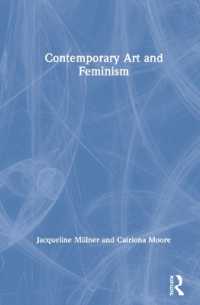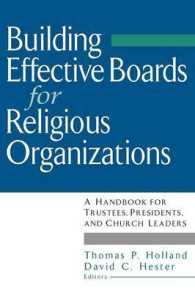Full Description
The decades-long problem of disproportionate school discipline and school-based arrests of students with disabilities, particularly those who also identify as Black or Native American, is explored in this authoritative book. A team of interdisciplinary scholars, attorneys, and education practitioners focus on how disparities based on disability intersect with race and ethnicity, why such disparities occur, and the impacts these disparities have over time. A DisCrit and research-based perspective frames key issues at the beginning of the book, and the chapters that follow suggest promising practices and approaches to reduce the inequitable use of school discipline and increase the use of evidence-supported alternatives to prevent and respond to behaviors of students with disabilities. The final chapter recommends future research, policy, legal, and practice goals, suggesting an agenda for moving the field forward in years to come.Book Features:
Explores how students' disabilities, race, ethnicity, and gender intersect to explain how they are negatively impacted by the overuse of suspension, expulsion, and school policing.
Focuses on practical changes to the approaches of research, practice, and policy to remedy this long-standing problem.
Presents an interdisciplinary approach, bringing together the expertise of scholars, attorneys, and educational practitioners to address the issues from a variety of perspectives.
Draws on DisCrit (Disability Studies and Critical Race Theory) to explore the intersection of race and ethnicity, particularly among students who are Black or from a Native American background and are considered "disabled."
Contents
Contents
Foreword Kent McIntosh ix
Acknowledgments xi
INTRODUCTION: FRAMING DISCIPLINE DISPARITIES THROUGH A DISCRIT INTERDISCIPLINARY LENS
1. Introductory Comments: An Interdisciplinary Lens in Addressing Discipline Disparities of Students With Disabilities 3
Pamela Fenning and Miranda Johnson
2. Looking at School Discipline From the Perspective of Critical Race Theory and DisCrit: How Multiple Identities Intersect to Create Inequities in School Discipline 14
Markeda Newell and Emma Healy
RESEARCH AND KNOWLEDGE THROUGH MULTIPLE EPISTEMOLOGIES, METHODS, AND VOICES
3. Let the Students Speak: African American Males With Disabilities' Perspectives of Behavior Intervention Acceptability in Schools and the Implications for Cultural Validity 29
Patrice M. Leverett
4. School Discipline at the Intersection of Race and Ability: Examining the Role of Police in Schools 46
Amy E. Fisher and Benjamin W. Fisher
5. Black Women Teachers' Counternarratives on School Discipline: Ability in Student, Teacher, and Space 64
Angelina N. Nortey
PROMISING EDUCATIONAL PRACTICES TO ADDRESS DISCIPLINE DISPROPORTIONALITY
6. Trauma and Discipline Disproportionality: Treating the Underlying Concerns 87
Kristen Pearson, Laura Marques, Monica Stevens, and Elizabeth Marcell Williams
7. Improving Educator Use of Data-Informed Decision-Making to Reduce Disciplinary Infractions for Students With Emotional Disturbance 108
Sandra M. Chafouleas, Amy M. Briesch, Kathleen Lynne Lane, and Wendy Oakes
8. The Use of the Assessment of Culturally and Contextually Relevant Supports (ACCReS) in High-Need Public School Classrooms 124
Lindsay M. Fallon and Margarida Veiga
9. Building Bridges: An Alternative to Suspension Program 140
Emma Healy, Michelle Rappaport, and Carly Tindall-Biggins
LEGAL AND POLICY APPROACHES TO ADDRESS DISCIPLINE DISPROPORTIONALITY
10. Changing the Conversation: Moving From Exclusionary Discipline to Trauma-Informed and Culturally Appropriate Practices to Improve Outcomes for Native American Students With Disabilities 161
Heather A. Hoechst and Donald Chee
11. Disproportionate Encounters of School Security Personnel and Students With Disabilities: An Update of the Case Law 177
Thomas A. Mayes and Perry A. Zirkel
12. Rethinking Discipline of Students With Disabilities: A Path Forward for Research, Policy, and Practice 194
Miranda Johnson and Pamela Fenning
Appendix A. Assessment of Culturally and Contextually Relevant Supports (ACCReS) 211
Appendix B. Building Bridges Materials 217
Appendix C. School Disciplinary Provisions Relating to Students With Disabilities 219
Notes 221
References 223
Index 259
About the Editors and Contributors 271








